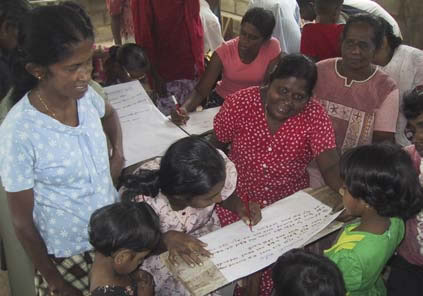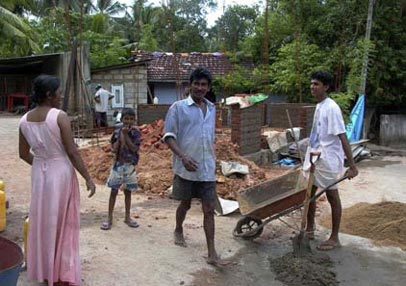Casestudy 12Sri Lanka
Post-tsunami reconstruction
and rehabilitation in Galle
- description
- further information
The tsunami that struck southern Sri Lanka in 2004 resulted in the death or displacement of more than half a million people and the destruction of community infrastructure such as wells, drainage, community centres, preschools, schools and roads. Responding to this disaster, UN-Habitat’s Rebuilding Community Infrastructure and Shelter (RCIS) project in Galle focused not only on rebuilding houses but also on supporting communities in the reconstruction of infrastructure. In the 12 months prior to March 2006, the programme assisted 700 households in 10 tsunami-affected communities
RCIS used a participatory approach that aimed for community-wide impacts through empowering vulnerable people and giving a voice to the tsunami-affected. This included:
- The organization of representative bodies to enable communities to take decisions regarding their own rebuilding process;
- A key role for target communities in rebuilding essential physical facilities, including shelter, so that they could restart functioning as normal communities;
- A livelihood component that encouraged the establishment of small-scale enterprises, creating wage employment and investment in the rebuilding process as a way of contributing to the recovery of the local economy.

© Katja Schäfer
During the process, self-confidence among the beneficiary community has been generated and human dignity restored by fully engaging in the reconstruction those who had suffered but survived the tragedy. Not only were buildings rebuilt, but also shattered lives and communities and self-reliance. Community governance has been re-established as well as self-managed, creating sustainable acommunities with social facilities and livelihood opportunities
Community Development Councils and Action Plans
As part of the RCIS project’s community mobilization activities in the target communities, community development councils (CDCs) were revived, strengthened and, where not in place, established to represent the interests of the wider community. CDCs provided an important institutional link for incorporating community views in Galle’s government and helping to implement locally developed Community Action Plans (CAPs), which prioritized needs and identified the actions that would help in addressing these needs. CAPs developed the capacity of communities to take appropriate action for their own development in the framework for the implementation of actions decided on by the communities. Importantly, the identification of needs was not viewed as making a ‘wish list’ of what communities wanted to be provided as an entitlement, but as a process of understanding their situation and what they needed to do to overcome it in the shortest possible time.

© Katja Schäfer
Community Contracting
After a CAP was established with a community, priority areas of assistance were identified and the UN-Habitat Project Office and the CDC of each affected community approved the plan. Subsequently, CDCs, operating as contractors, were in charge of implementing the works according to the agreed schedule of works, specifications, drawings and estimates within an indicated time frame. As the RCIS project promoted cooperation between the different actors in improving the local urban areas, the UN-Habitat Project Office in Galle initially mediated between the different actors. During the course of the project, it withdrew gradually and allowed more room for community decisions and interaction with other partners. In this regard, the RCIS project was a means for empowering communities to take more control of their own lives and seek further assistance not only in reconstructing the tsunami affected physical infrastructure but also in improving their neighbourhoods in the long term.
The communities gained directly from the project implementation through employment as well as through the outputs of the project itself. Furthermore, because community members were directly affected by the way in which the reconstruction work was carried out and because benefits of local contracts went directly back into the community as opposed to an intermediate actor, there was a strong incentive to see that work was carried out properly. Whereas conventional procurement of reconstruction works had a single benefit, the provision of shelter or the infrastructure itself, community partnering doubled the benefits obtained from investment. Physical infrastructure was provided along with skills development and income-generating activities.

© Katja Schäfer
Possible employment opportunities arose not only during the implementation of the project, but additionally as small-scale enterprises were created in the community. Through on-the-job training community groups were capable of undertaking tasks of which they had no previous experience. Skilled labour was hired as much as possible from within the community or adjacent areas with residents who were experienced skilled construction workers. These workers played a key role in managing the construction process and had the potential to act as trainers and demonstrators for less experienced individuals.
Go back to case studies listing
Habitat Programme Manger
UN-Habitat - Colombo, United Nations Human Settlements Programmes
UNDP, 202-204 Bauddhaloka Mawatha
Colombo 7, Sri Lanka<
Tel: +94 (0) 11 2580691 Ext: 342
Fax: +94 (0) 11 2581116
e-mail: info@unhabitat.lk, conrad.detissera@undp.org
Website: www.unhabitat.lk
City Rehabilitation Advisor
UN-Habitat – City Project Office Galle
e-mail: katja.schafer@gmail.com
